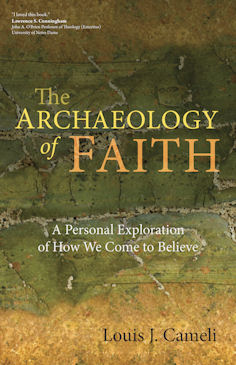
|
Posted April 20, 2015
Book: The Archaeology of Faith: A Personal Exploration of How We Come to Believe Author: Louis J. Cameli Ave Maria Press. Notre Dame, IN. 2015. Pp. 205 An Excerpt from the Preface:
The Verdi Paradox On the occasion of Giuseppe Verdi's two-hundredth birthday, Riccardo Muti led the Chicago Symphony Orchestra and chorus in an extraordinary and memorable performance of Verdi's Requiem. . . .What move me most in that performance was the intense quality of prayer conveyed by the music. . . .Verdi was baptized the day after his birth and raised a Catholic. As he matured, however, he was caught up, as much of nineteenth-century Italy was, in the anticlericalism and anti-Church climate of the Risorgimento, a movement that sought to unify Italy and that viewed the Church and religion as obstacles to forging a national identity. Perhaps more decisive for his personal spiritual journey was the death of his two infant children, the only children he would ever have, and then shortly afterward the death of his wife, Margherita Barezzi, at the age of twenty-six. These were losses from which he never fully recovered and that inevitably shook whatever religious faith he had. Still, something of faith seems to have remained in Verdi. The religious power of his music makes that evident. And that power is undeniable, as I experienced it. Pope Benedict XVI spoke of Verdi's ateismo inquieto, his restless atheism that kept in some measure the religious quest alive in him. I call it the "Verdi paradox," and it is the mysterious conjunction of nonbelieving believer. The Verdi paradox alerts us to the complex nature of faith. The paradox warns us not to assume that we all mean the same thing when we use the word "faith." We live in a strange cultural and historical moment when both self-professed believers and nonbelievers alike often reduce and distort religious faith to conform to their preconceptions of what they think faith ought to be. Curiously both believers and nonbelievers often get it wrong in roughly the same say. For example, they may speak about faith but really mean fideism, a blind assent to religious truths that makes no room for reasonableness, human struggle, freedom, or even a general sense of human flourishing. This shared sense of faith as fideism leaves no room in this universe for God and humanity to be together, much less to be in close relationship. This mistaken sense of faith much to militant secular atheists as to religiously conservative fundamentalists. . . .In our time and culture, as I perceive it, the faith that nonbelievers deny and that fundamentalists affirm is a flat reality. It is one-dimensional. Genuine faith, in stark contrast, is complex, richly textured, and always deeply human, even as it moves beyond itself and connects with divine transcendence. I am convinced – or more accurately, passionately convinced --- that we must modify our basic understanding and appreciation of faith. This shift means recovering a genuine sense of faith. Without that recovery, we will lose an essential piece of ourselves. With an authentic sense of faith, however, we can find and sustain our true selves and reclaim our humanity, which only finds fulfillment beyond itself in relationship to God. In this book, I have tried to stand before faith in all its complexity and richness. I have tried to look at the experience of faith in different ways. I have not mastered faith. No one ever does. My best hope is that I have moved a little closer to a more genuine understanding and appreciation of real faith in its richness and complexity. And if I have accomplished that bit of forward movement, it is enough. An Excerpt from the Book: "What does it mean for me to know that countless people in earlier generations have handed on the faith so that I can receive it today? How do I understand my responsibility to continue this handing on?" "How aware am I that others have paid a costly price, sometimes with their very lives, so that I can believe today?" Table of Contents: Part I: The Archaeology of Faith: A Personal Exploration 1. Cuprae Fanum: At the temple of the goddess Cupra 2. The arrival of the Romans 3. Emidio, bishop and martyr and saint 4. Benedictine presence and the church of San Martino 5. Saracen pirates 6. Working the land 7. Francis of Assisi and Franciscans 8. The Church, the state, and the challenge of faith 9. Honest faith, the inquisition, and the reformation 10. Teatro dell'Arancio, Orange Tree Theater: Renaissance, scientific revolution, enlightenment, and Romanticism 11 Immigration: struggle, promise, and hope 12. Faith given and then claimed: early years 13. Considered faith: studying faith for understanding and communion 14. Transformed and transforming faith 15. Elements of an agenda for the continuing journey of faith Part II: A Theological Account of Faith: Organizing and Understanding Our Experience 16. Foundations of faith: our capacity to receive God's Word and believe 17. Foundations of faith: God's revelation and self-communication 18. Our response to God's revelation: our act of faith and believing in God 19. The process of faith: from the act of faith to faith's consummation 20. Particular aspect of faith Part III: Biblical Accounts of Faith: Expanding Our Experience 21. Nicodemus: a believer is reborn 22. The Samaritan Woman: the unlikely believer 23. Martha: love, death, and new faith in Jesus 24. Thomas: the apostle of certain faith |
|
